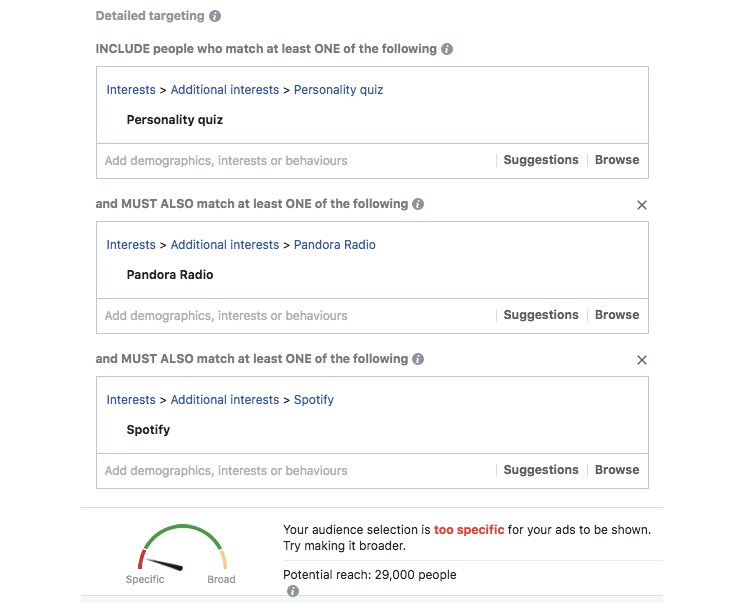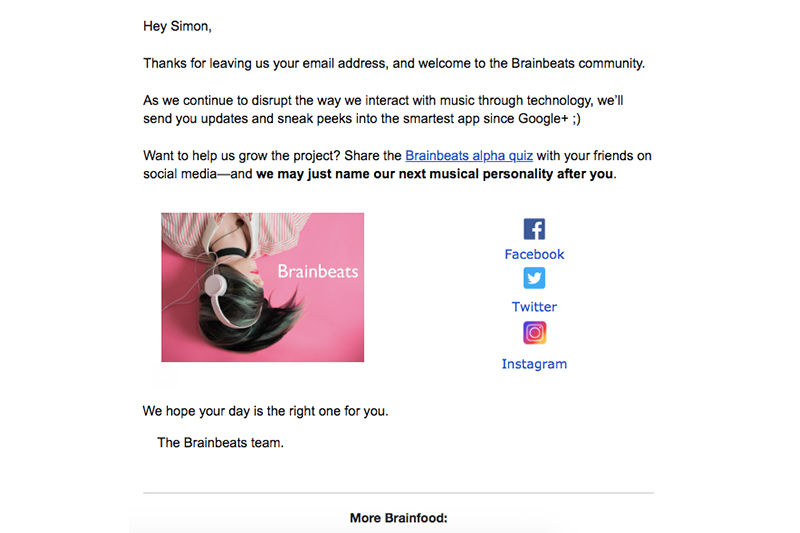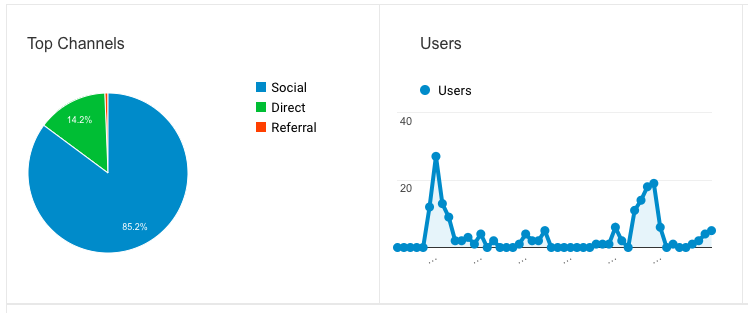Social media marketing strategy in 7 steps
We started our own social media business to help us find out how to create objectives, define an audience, craft a social media persona, and much more.<br>

So you’re excited about the potential of social media marketing, aware of the challenges, and keen to get started. Great news.
But before you start inviting distant relatives and high school acquaintances to ‘like’ your new Facebook business page, there are few things you should think about.
What do you want to achieve? Who’s your audience? What should you post? How does it fit into your overall marketing strategy?
Some of these questions need experimentation to get right. But you should still come up with a coherent social media marketing strategy.
As my gym teacher would say if you forgot your shorts: “By failing to prepare, you’re preparing to fail.” And if there’s one place you don’t want to get caught short-less, it’s on social media.
So let’s start tackling those questions. We’ll also use our fledgling social media venture Brainbeats as an example of how to think about each point.
Setting your goals for social media marketing
“In three months, I want 20,000 page views and a retweet from Barack Obama.”
This probably isn’t the kind of social media goal you need right now.
Why? Because likes, shares, and followers don’t equal success on their own. Unless your business model is to get Insta-famous like Kim K, but that’s a whole other article.
In other words, take advantage of social media—don’t let it take advantage of you. Look beyond the likes and ask yourself “Why am I doing this?”
Here are some objectives that social media can help with:
Build brand awareness
Got a shiny new brand? Social media is a great place to get it through eyeballs and into memories. Reach, views, and engagement are what you’re after.
Increase website traffic
Your social media is not a final destination—it’s a channel to your blog content or company website. Besides, people spend way too much time on social media sites anyway, so by siphoning them off to your own domain you’re practically doing them a favor.
Boost your sales
You don’t care if people retweet your latest Twitter retort, or how they rate your hashtag game. You only want them to click through to your store and buy your stuff.
Promote your promotions
Sundays are slow in the cafe, so breakfasts are now 30% off. But if people aren’t already in the cafe, how will they know? Use social media to get the word out and create a buzz.
Build a community
Start better conversations with your customers by offering a more direct support channel. Conduct a brand perception survey to get a feel for your customers and start better conversations with them. Or just give them a space to bond over how much they love your business. Social media is the place to do it.
Attract better leads
Want to reach 34-year-old Sega fans in Michigan? Target them with social media. Create ads to get them to follow your page, or run a promotion that asks for their email addresses. Now you have a captive audience ready to buy your old Sonic games.
These are just a few possible social media objectives. And remember that the goals you settle on will influence the rest of your social media marketing strategy—so give it some thought.
Understanding your audience
Remember back in the last chapter when I said that social media marketing is important because your audience is there? Well, it’s true. But you still have to figure out which channels they’re on, when they’re on it, and how they use it.
The good news: you already know your customers better than anyone else. Start by looking up some basic info on social media demographics—which vary a lot across social media networks,
You’re unlikely to find out that 29% of Swiss construction workers send Snapchats at 4 am. But general stats about the ages, genders, and locations of social media users—and which channels they use—are easily available with a quick Google search.
Already have a social media following? Feed it into Facebook to make a lookalike audience. Then experiment with different types of content to find out what makes your potential customers tick.
Lastly, think about what time your audience is online. Nowadays, paid ad targeting helps a lot with this, particularly on Facebook. But it still makes a difference on platforms that order content chronologically—like Twitter, for example.
Picking the right social media channels
Don’t know your WhatsApps from your Snapchats? Research each social media network, try them out, and pick the one that best fits your business.
If you’re a post-millennial teen raised on a daily diet of hashtags and notifications, it’ll be a walk in the park. But for the rest of us, the number of new social media platforms popping up can feel pretty overwhelming.
So when you’re getting started, focus on one or two at most.
Not sure where to begin? Facebook is the easy answer. It dwarfs every other channel in terms of daily users, has tons of targeting and advertising options, and allows tons of content formats.
But there are caveats. Facebook is flooded with business pages just like yours, so it’s increasingly difficult to stand out. And unlike most other platforms, it’s almost impossible to get your content seen without paying for it—and those $10 post boosts do add up.
If you decide to start with another channel, make sure it suits your product.
For example, if you want to show off your product, start a YouTube channel and post video demonstrations. Blendtec’s infamous YouTube series “Will it blend?” does a great job of this. Who wouldn’t want to find out if their hyper-powered blender is a match for the iPhone X?
Or if your business is more about lifestyle, inspire people with a well-curated Instagram feed. Offering a niche solution to a very specific audience? You could start lurking on the appropriate subreddit and build a reputation there.
Just don’t spread your efforts too thin. Start with one channel, build an audience, then use your newfound social media gravitas to kickstart campaigns on other platforms.
Crafting your social media persona
Forget social media for a second—every brand needs a personality or voice that people can relate to. This is what distinguishes your business from its competitors, and inspires trust in potential customers.
How your company represents itself on social media should be a natural extension of its core identity. But at the same time, your tone and content also need to be tailored to your channel of choice.
Succeeding at this is a lot easier than it sounds, as long as you follow the Kanye West rule: be authentic. That’s right—Kanye is an example to us all when it comes to social media.
Why? Because love him or hate him, he says exactly what’s on his mind at any time. His business is his personality. And by constantly broadcasting it on social media with no filter whatsoever, he has attracted a gigantic online following.
I’m not saying you should start posting whatever’s in your head on social media. But if you stay true to your brand’s identity, people will engage. Pretend to be something you’re not, and people will switch off.
Need an example? MailChimp’s brand leaves space for monkeying around. So they add some humor by sprinkling their monkey business onto your newsfeed like this:
Think about your business values, then use these as the starting point of your social media conversations.
Coming up with content
It’s not just how you post—it’s what you post. Here are a few general tips when posting content on any channel:
Visual wins
Pictures are pretty much essential when posting content, and videos are even better. 64% of customers are more likely to buy a product after watching a video about it.
Copy is still key
Even though images grab people’s attention, the accompanying copy is make or break for engagement with your content. Experiment until you find a winning combination.
Steal the limelight
Seen an article, GIF, or meme relevant to your business that’s killing it on social media? Repost or share it to hijack some of the attention.
Start blogging
As a blogger, I can’t leave this one out. Don’t just recycle articles—write your own. That way when people click the link, they go straight to your website.
Keep it consistent
Strike a balance between varying content and maintaining a constant theme. People should know what to expect when they head to your page.
Check the competition
Observe what your competitors are posting and how they interact with their fans. There’s no shame in taking inspiration from your rivals.
Respond quickly
When someone reaches out to you by commenting on your post, reach back. People will be more inclined to engage with you if they know you’re listening.
Content is the bread and butter of social media marketing, so there’s a lot to talk about here.
But first and foremost, it should be suited to the specific social media channel. So in later chapters, we’ll go in depth on what works and what doesn’t on Facebook, Twitter, and Instagram.
Syncing your marketing efforts
Unless your company exists solely on social media, chances are you already have other marketing initiatives going on. Blending these with your social media marketing strategy could give you a huge head start when building a following.
Think about it: Coca-Cola doesn’t have 107 million likes on Facebook because it’s the pinnacle of online coolness—although I’m sure they have some very smart people doing their social media marketing.
It’s because Coca-Cola was already massive. So when Facebook came along in the late 00s, Coke simply called upon their red and white magic to summon an army of followers overnight.
You can leverage your own marketing presence to give yourself a leg up on social.
Do you already send out a newsletter? Add social media icons and URLs—along with your emails, posters, and shop windows. Run competitions in your store or on your website that encourage people to follow you on social media.
By using your existing marketing channels to kickstart your social campaign, you’re giving yourself a boost at hardly any extra cost. This will ease the grind of building a social media following from nothing.
Making room for improvement
If you’ve followed all the steps in this chapter, you should be on the path to becoming a social media Shakira. It’s a lot to think about, so congrats for getting this far. Chill for a minute, pour yourself a drink.
Because we’re about to dip into the wild world of analytics.
Seriously though, it’s important to know how your social media marketing is going. When it’s going well, looking at all those graphs and numbers can be very satisfying. And if it’s not going well, at least you know about it so you can make adjustments.
Facebook and Google analytics are both fantastic places to start—they’re free to use, they give clear insights that are easy to understand, and they’re improving all the time.
But if you really love your stats, consider paying for a service like Hootsuite or Sprout Social. For more info, read our article on social media tools.
They provide incredibly detailed rundowns of which posts work and which don’t. They can also optimize your content schedule across multiple channels, and even produce reports on your competitors.
Overall, there’s a hell of a lot you can do with analytics. We’ll talk about Facebook, Twitter, and Instagram analytics in their relevant chapters.
That just about wraps it up for social media marketing strategy.
Next up is the big F. Stay tuned for detailed Facebook tips and the next chapter in the Brainbeats saga.
Liked that? Check these out:
.webp)
Tips
12 customer satisfaction questions that reveal real insights
Customer satisfaction surveys getting vague answers (or no answers at all)? The problem isn't your customers, it's your questions. Use these 12 CSAT questions to ask the right questions at the right time to boost response rates—and help you improve your customer experience.
Más información

Tips
14 examples of ranking survey questions to use in 2026
Get to know your customers and use their survey responses to make data-driven decisions with ranking survey questions that help you uncover more. We’ve rounded up 14 real-world examples to inspire your next survey and make creating effective ranking questions effortless.
Más información



















